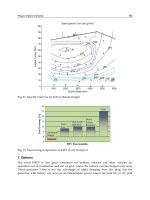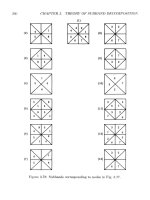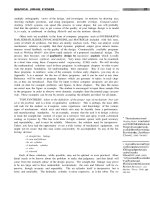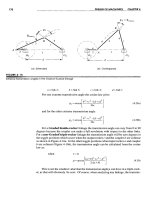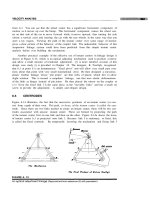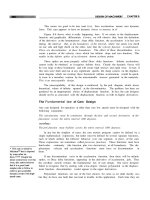DESIGN OF MACHINERYAN INTRODUCTION TO THE SYNTHESIS AND ANALYSIS OF MECHANISMS AND MACHINES phần 6 potx
Bạn đang xem bản rút gọn của tài liệu. Xem và tải ngay bản đầy đủ của tài liệu tại đây (5.1 MB, 93 trang )
HVPOID
GEARS
If the axes between the gears are nonparallel and also nonintersect-
ing, bevel gears cannot be used.
Hypoid
gears will accommodate this geometry. Hy-
poid gears are based on rolling hyperboloids of revolution as shown in Figure 9-23. (The
term hypoid is a contraction of hyperboloid.) The tooth form is not an involute. These
hypoid gears are used in the final drive of front-engine, rear wheel drive automobiles, in
order to lower the axis of the driveshaft below the center of the rear axle to reduce the
"driveshaft hump" in the back seat.
Noncircular Gears
Noncircular gears are based on the rolling centrodes of a Grashof double-crank fourbar
linkage. Centrodes are the loci of the instant centers of the linkage and were described
in Section 6.5 (p. 263). Figure 6-15b (p. 266) shows a pair of centrodes that could be
used for noncircular gears. Teeth would be added to their circumferences in the same
way that we add teeth to rolling cylinders for circular gears. The teeth then act to guar-
antee no slip. Of course, the velocity ratio of noncircular gears is not constant. That is
their purpose, to provide a time-varying output function in response to a constant veloc-
ity input. Their instantaneous velocity ratio is defined by equation 6.llf (p. 258). These
devices are used in a variety of rotating machinery such as printing presses where varia-
tion in the angular velocity of rollers is required on a cyclical basis.
Belt and Chain Drives
VEE BELTS
A vee belt drive is shown in Figure 9-2 (p. 433). Vee belts are made of elas-
tomers (synthetic rubber) reinforced with synthetic or metallic cords for strength. The pul-
leys, or sheaves, have a matching vee-groove which helps to grip the belt as belt tension
EPICYCLIC OR PLANETARY GEAR TRAINS
The conventional gear trains described in the previous sections are all one-degree-of-free-
dom (DOF) devices. Another class of gear train has wide application, the epicyclic or
planetary train. This is a two-DOF device. Two inputs are needed to obtain a predict-
able output.
In
some cases, such as the automotive differential, one input is provided (the
driveshaft) and two frictionally coupled outputs are obtained (the two driving wheels). In
other applications such as automatic transmissions, aircraft engine to propeller reductions,
and in-hub bicycle transmissions, two inputs are provided (one usually being a zero ve-
locity, i.e., a fixed gear), and one controlled output results.
Figure 9-32a shows a conventional, one-DOF gearset in which link I is immobilized
as the ground link. Figure 9-32b shows the same gearset with link 1 now free to rotate
as an arm which connects the two gears. Now only the joint
02
is grounded and the
system DOF
=
2. This has become an epicyclic train with a sun gear and a planet gear
orbiting around the sun, held in orbit by the arm. Two inputs are required. Typically, the
arm and the sun gear will each be driven in some direction at some velocity. In many
cases, one of these inputs will be zero velocity, i.e., a brake applied to either the arm or
the sun gear. Note that a zero velocity input to the arm merely makes a conventional train
out of the epicyclic train as shown in Figure 9-32a. Thus the conventional gear train is
simply a special case of the more complex epicyclic train, in which its arm is held sta-
tionary.
In this simple example of an epicyclic train, the only gear left to take an output from,
after putting inputs to sun and arm, is the planet. It is a bit difficult to get a usable output
from this orbiting gear as its pivot is moving. A more useful configuration is shown in
Figure 9-33 to which a ring gear has been added. This ring gear meshes with the planet
and pivots at
02,
so it can be easily tapped as the output member. Most planetary trains
will be arranged with ring gears to bring the planetary motion back to a grounded pivot.
Note how the sun gear, ring gear, and arm are all brought out as concentric hollow shafts
so that each can be accessed to tap its angular velocity and torque either as an input or an
output.


